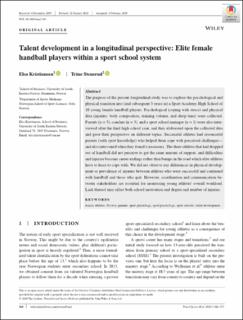| dc.contributor.author | Kristiansen, Elsa | |
| dc.contributor.author | Stensrud, Trine | |
| dc.date.accessioned | 2020-08-31T09:29:17Z | |
| dc.date.available | 2020-08-31T09:29:17Z | |
| dc.date.created | 2020-02-19T13:56:42Z | |
| dc.date.issued | 2020 | |
| dc.identifier.citation | Translational Sports Medicine (TSM). 2020, 3(4), 364-373. | en_US |
| dc.identifier.issn | 2573-8488 | |
| dc.identifier.uri | https://hdl.handle.net/11250/2675646 | |
| dc.description | This is an open access article under the terms of the Creative Commons Attribution-NonCommercial-NoDerivs License, which permits use and distribution in any medium, provided the original work is properly cited, the use is non-commercial and no modifications or adaptations are made. | en_US |
| dc.description.abstract | The purpose of the present longitudinal study was to explore the psychological and physical transition into (and subsequent 3 years in) a Sport Academy High School of 10 young female handball players. Psychological (coping with stress) and physical data (injuries, body composition, training volume, and sleep time) were collected. Parents (n = 5), coaches (n = 3), and a sport school manager (n = 1) were also interviewed after the final high school year, and they elaborated upon the collected data and gave their perspective on different topics. Successful athletes had resourceful parents (with sport knowledge) who helped them cope with perceived challenges—and also intervened when they found it necessary. The three athletes that had dropped out of handball did not perceive to get the same amount of support, and difficulties and injuries become career endings rather than bumps in the road which elite athletes have to learn to cope with. We did not observe any differences in physical development or prevalence of injuries between athletes who were successful and continued with handball and those who quit. However, coordination and communication between stakeholders are essential for monitoring young athletes' overall workload. Lack thereof may affect both school motivation and degree and number of injuries. | en_US |
| dc.language.iso | eng | en_US |
| dc.subject | female athletes | en_US |
| dc.subject | Norway | en_US |
| dc.subject | parents | en_US |
| dc.subject | sport physiology | en_US |
| dc.subject | sport psychology | en_US |
| dc.subject | sport schools | en_US |
| dc.subject | talent development | en_US |
| dc.title | Talent development in a longitudinal perspective: Elite female handball players within a sport school system | en_US |
| dc.type | Peer reviewed | en_US |
| dc.type | Journal article | en_US |
| dc.description.version | publishedVersion | en_US |
| dc.rights.holder | © 2020 The Authors | en_US |
| dc.source.pagenumber | 364-373 | en_US |
| dc.source.volume | 3 | en_US |
| dc.source.journal | Translational Sports Medicine (TSM) | en_US |
| dc.source.issue | 4 | en_US |
| dc.identifier.doi | 10.1002/tsm2.143 | |
| dc.identifier.cristin | 1795844 | |
| dc.description.localcode | Institutt for idrettsmedisinske fag / Department of Sports Medicine | en_US |
| cristin.ispublished | true | |
| cristin.fulltext | original | |
| cristin.qualitycode | 1 | |
